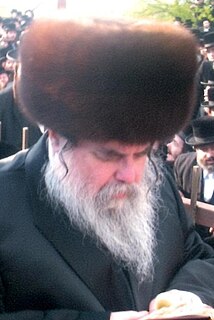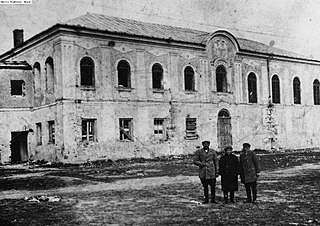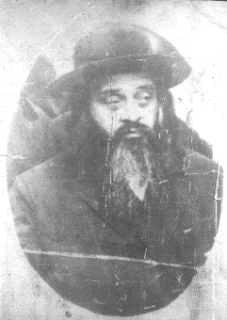
Vizhnitz is the name of a Hasidic dynasty founded by Rabbi Menachem Mendel Hager. Vizhnitz is the Yiddish name of Vyzhnytsia, a town in present-day Ukraine.

Nadvorna is a Hasidic rabbinical dynasty within ultra-Orthodox Judaism. The dynasty derives its name from the town of Nadvorna, known in Ukrainian as Nadvirna. The town was located in the province of East Galicia in the Austro-Hungarian Empire, until World War I; and between the two world wars, the town was located in Poland.

Belz is a Hasidic dynasty founded in the town of Belz in Western Ukraine, near the Polish border, historically the Crown of the Kingdom of Poland. The group was founded in the early 19th century by Rabbi Shalom Rokeach, also known as the Sar Shalom, and led by his son, Rabbi Yehoshua Rokeach, and grandson, Rabbi Yissachar Dov, and great-grandson, Rabbi Aharon, before the Nazi invasion of Poland in 1939. While Rabbi Aharon managed to escape Europe, most of the Belz Hasidim were killed. Rabbi Aharon re-established the Hasidut in Tel Aviv, Israel. Today, Belz is one of the largest Hasidic groups in Israel, and has sizable communities in England, Belgium, New York, New Jersey, Canada, and Australia.
Chernobyl is a Hasidic dynasty that was founded by Grand Rabbi Menachem Nachum Twersky, known by the name of his work as the Meor Einayim. The dynasty is named after the northern Ukrainian town of Chernobyl, where Rabbi Nachum served as the maggid. The attribution of Chernobyl Hasidism continued from the second generation of Hasidic Judaism to the present day. Chernobyl is considered one of the famous courtyards of the Hasidic movement. The lineage has existed since its establishment and to this day in a row, although not always with the name Chernobyl. Today there are several rebbes named Chernobyl. The central courtyard is in Bnei Brak, headed by Rabbi Menachem Nachum Twersky.

Yissachar Dov Rokeach is the fifth and present Rebbe of the Hasidic dynasty of Belz. He is the son of Rabbi Mordechai of Bilgoray, the grandson of the third Belzer Rebbe, Rabbi Yissachar Dov Rokeach, and the nephew of the fourth Belzer Rebbe, Rabbi Aharon Rokeach, who raised him. He has led Belz since 1966.

Slonim is a Hasidic dynasty originating in the town of Slonim, which is now in Belarus. Today, there are two Slonimer Rebbes, both in Israel: One resides in Jerusalem, and the other in Bnei Brak. Colloquially, the Jerusalem side is called the "White" (Veissa) side, and the Bnei Brak side is called the "Black" (Shvartza). When Slonim Hasidim split into separate factions, the leader of one, Rabbi Sholom Noach Berezovsky, had a white beard, and the leader of the other, Rabbi Avraham Weinberg, had a black beard. The factions are distinguished by different Hebrew spellings, the Jerusalem group being known as סלונים and the Bnei Brak group being known as סלאנים. They are two distinct groups today, and have many differences between them.

Sadigura is a Hasidic dynasty named for the city of Sadhora, Bukovina, which belonged to Austria. The dynasty began in 1850 with Rabbi Avrohom Yaakov Friedman, a son of Rabbi Yisrael Friedman of Ruzhyn, and was based in Sadigura until 1914. During the interwar period the dynasty was led by Rebbes in Vienna and Przemyśl, Poland, and on the eve of World War II was transplanted to Israel, where it thrives to this day.

There are two Hasidic Jewish dynasties known as Cleveland and both are considered to be a part of the Nadvorna dynasty.
A Moetzes Gedolei HaTorah is the supreme rabbinical policy-making council of the Agudat Yisrael and Degel HaTorah movements. Rabbis sitting on the various Moetzos are usually either one of the more prestigious Roshei Yeshiva or Hasidic rebbes who are also usually regarded by many Haredi Jews to be the Gedolim ("great/est") sages of Torah Judaism. Before the Holocaust, it was the supreme authority for the World Agudath Israel in Europe.

Izhbitza-Radzin is the name of a dynasty of Hasidic rebbes. The first rebbe of this dynasty was Rabbi Mordechai Yosef Leiner, author of Mei Hashiloach, in the city of Izhbitza.. Rabbi Mordechai Yosef founded his own Hasidic movement in the year 5600 (1839), with Rabbi Mordechai Yosef leaving the court of Rabbi Menachem Mendel of Kotzk.
Makova is a Hasidic court, centered in Kiryat Ata and has its roots in the city of Makó, Hungary. It is headed by Rabbi Shimon Lemberger.
Avraham Abba Leifer was the second Rebbe of the Pittsburg Hasidic dynasty and the instigator for the relocation of the Hasidut from its original location in Pittsburgh, Pennsylvania to the Israeli coastal city of Ashdod. He was widely known for his yiras Shamayim, humility and friendliness toward Jews of all backgrounds.
Yosef Leifer was the founder and first Rebbe of the Pittsburg Hasidic dynasty in Pittsburgh, Pennsylvania, which he led for 42 years. Known as the Tzidkas Yosef after the name of his posthumously-published sefer, he was a scion of the Nadvorna dynasty.

Mordechai Yissachar Ber Leifer is the third and current Rebbe of the Pittsburg Hasidic dynasty. Since succeeding his father, Grand Rabbi Avraham Abba Leifer, as Rebbe in 1990, he has expanded the Hasidic presence in Ashdod, Israel with new schools and institutions, and increased the number of Pittsburger families to 100 in Ashdod. He also shepherds Pittsburg Hasidim in Jerusalem, Bnei Brak, Beit Hilkia, New York City and California. He and his Rebbetzin, who speak English, Hebrew and Yiddish, have a personal relationship with each member of the Hasidut.

Shlomo Chanoch Hakohen Rabinowicz was the fourth and last Rebbe of the Radomsk Hasidic dynasty. He was the eldest son of the third Radomsker Rebbe, Rabbi Yechezkel Hakohen Rabinowicz and great-grandson of the founder of the dynasty, Rabbi Shlomo Hakohen Rabinowicz, the Tiferes Shlomo. Under his leadership, Radomsk grew to be the third largest Hasidut in Poland, after Ger and Alexander. Rabinowicz built a network of 36 yeshivas across Poland and Galicia that enrolled over 4,000 students by 1939. He was murdered in the Warsaw Ghetto together with his entire family.
Radomsk is a Hasidic dynasty named after the town of Radomsko in Łódź province, south-central Poland. The dynasty was founded in 1843 by Rabbi Shlomo Hakohen Rabinowicz, one of the great Hasidic masters of 19th-century Poland. His son, grandson and great-grandson led the dynasty in turn, attracting thousands of followers. On the eve of World War II, Radomsk was the third largest Hasidic dynasty in Poland, after Ger and Alexander.
Avrohom Yaakov Friedman, in English also spelled Abraham Jacob Friedman was the third Rebbe of the Sadigura Hasidic dynasty. He was a prominent Jewish leader in Vienna in the interwar period and in the nascent State of Israel, where he established his court in Tel Aviv. He was one of the first members of Agudat Israel and occupied a seat on the Moetzes Gedolei HaTorah.

Avrohom Yaakov Friedman was the fifth Rebbe of the Sadigura Hasidic dynasty. In 1979 he succeeded his father, the fourth Sadigura Rebbe, and took his seat on the Moetzes Gedolei HaTorah. He oversaw the growth of Sadigura communities in Israel and in London, Antwerp, and New York City.
Yosef Tzvi Dushinsky is the third Rebbe of the Dushinsky Hasidic dynasty of Jerusalem, Israel. He assumed the leadership of the Hasidut upon the death of his father, Rabbi Yisroel Moshe Dushinsky, second Dushinsky Rebbe, in 2003. The Dushinsky Hasidic movement was founded by his grandfather and namesake, Rabbi Yosef Tzvi Dushinsky, in Jerusalem in the 1930s. Both his father and grandfather also served as Gaavad of the Edah HaChareidis.

Rabbi Yisrael Moshe Friedman was the sixth Rebbe of the Sadigura chasidus. He led his court from Bnei Brak, Israel.